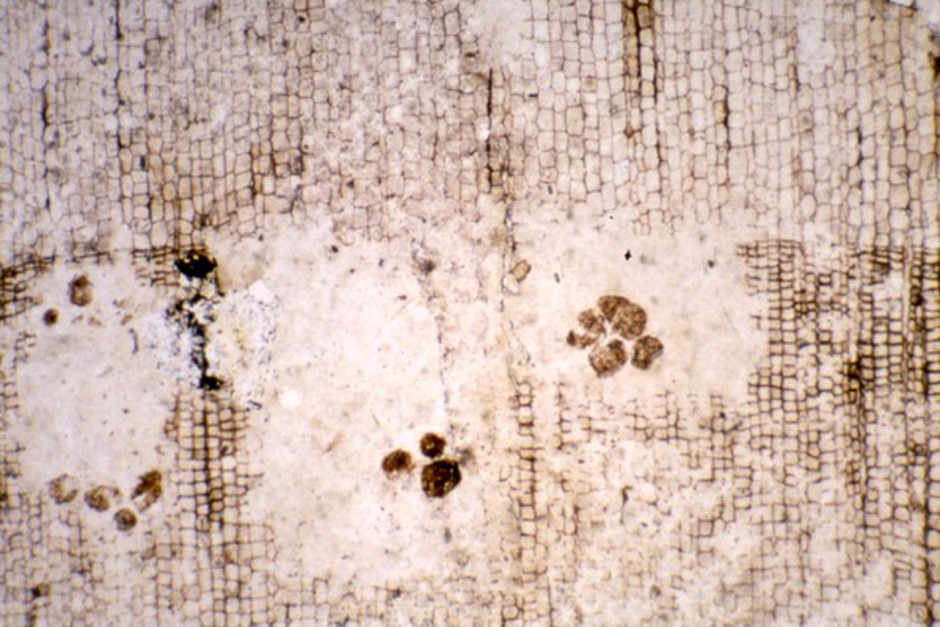Forskningsområden: Paleontologi
Forskningsämnen: Fossil, Taxonomi & artbeskrivning, Växtgrupper, Utdöenden, Växt-insektinteraktion
Project overview
Project period: 2023 - 2026
Participating departments from the museum: Paleobiology
This project will resolve the patterns of extinction and recovery of plant groups and their arthropod herbivores across the Guadalupian-Lopingian (middle-upper Permian) boundary—one of the most neglected biotic crises in Earth’s history.
Analyses of diagnostic feeding and egg-laying traces enable patterns of plant utilization by terrestrial arthropods to be charted through this extinction event. The study will utilize novel X-ray and fluorescence microscopy techniques and globally unique fossil assemblages from polar to equatorial paleolatitudes to provide unparalleled insights into continental ecosystem changes through the critical interval leading up to the end-Permian mass extinction.
This project will chart the changes in key terrestrial arthropod feeding strategies and document how plants responded to insect attack over evolutionary time scales. The results will elucidate the evolution of herbivory, parasitism, saprotrophy, detritivory and plant defences immediately prior to Earth’s greatest biotic crisis.
Project description
This study addresses five key questions related to the evolution, extinction and interactions of plants and insects during the final 15 million years of the Paleozoic using diverse techniques.
Did plant diversity and representation change across the end-Guadalupian event? Since the record of turnover among plants in continental ecosystems for this event has been little studied, this project will provide crucial data for changes in taxon richness, intra-order diversity, and group representation on land.
Are plant-arthropod damage traces informative of insect diversity and herbivory through time? Since insect body fossils are scarce, trace fossils on leaves and other plant organs arguably provide the best means of evaluating insect feeding-guild diversity for the middle–late Permian. In some cases, specific arthropod taxa can be linked to the traces based on diagnostic damage scar or coprolite form. This project will examine high-quality fossil assemblages through the critical 15-Myr interval from the mid-Guadalupian to end of the Permian (267–252 Ma: (Tables 1, 2; Figs 7, 8). Each assemblage will be surveyed for damage diversity, abundance, host plants, and plant responses, enabling assessment of how herbivore diversity/guild representation fared across the critical EGE and the lead-up to the end-Permian extinction.
How did component communities respond to biotic crises? Permian temperate and tropical forests were dominated by very different plants (Glossopteridales-Cordaitales in the south, and Voltziales-Gigantopteridales in the tropics). This project will study biotic associations linked to the dominant plant groups and assess whether communities collapsed as a whole during crises, or whether arthropods were able to switch to new hosts with the demise of their host plants.
Can borings in fossil wood inform about biotic shifts in guild dominance? Some have argued that wood-boring guilds fundamentally shifted in the Triassic: earlier examples being dominated by oribatid mites and later examples by insects. However, few Permian wood assemblages have been systematically analysed for arthropod damage. This project will evaluate wood-boring strategies based on woods from successive Australian–Antarctic units.
Can permineralized remains reveal parasitism/pathogen strategies on woody plants? Few studies have targeted certain invertebrate life strategies (e.g. gall-producers and fungivores) that are important parasites and pathogen vectors in modern ecosystems. Preliminary data show galls and fungi to be common in Permian silicified woods of Gondwana. Investigations of these fossils via thin-sectioning and tomography offer the potential to reveal the ecology of multitrophic (plant-fungal-arthropod) interactions.
Can coprolites reveal guild diversification in terrestrial herbivory through time? Microcoprolites are an under-appreciated resource in paleoecology. Bulk acid-maceration of plant-rich strata yields a wealth of fossil faecal pellets that can be used to identify diverse feeding strategies not easily detected from plant or insect macrofossils. Strategies such as palynophagy, fungivory, and saprophagy are readily detectable from microcoprolites, and their quantitative analysis through the middle to late Permian will gauge the relative success of generalist vs specialist herbivores.
Funding
- Vetenskapsrådet project 2022-03920 https://www.vr.se/
Selected publications
- Feng, Z., Sui, Q., Guo, Y. & McLoughlin, S. (2023). Specialized herbivory in fossil leaves reveals multi-evolutionary origins of nyctinasty. Current Biology 33, xxx–xxx. https://doi.org/10.1016/j.cub.2022.12.043
 External link.}
External link.} - Sui, Q., Sheng, Z.-H., Yang, J.-Y., Guo, Y., McLoughlin, S. & Feng, Z. (2023). Two new isoetalean (Lycopsida) megaspore species representing the earliest occurrence of Henrisporites from upper Permian strata of Southwest China. Review of Paleobotany and Palynology 314, 104894 https://doi.org/10.1016/j.revpalbo.2023.104894
 External link.
External link. - Peng, J., Slater, S.M., McLoughlin, S. & Vajda, V. (2023). New species of Kuqaia from the Lower Jurassic of Sweden indicates a possible water flea (Crustacea: Branchiopoda) affinity. PLoS ONE 18(6), e0282247. https://doi.org/10.1371/journal.pone.0282247
 External link.
External link. - Vajda, V., McLoughlin, S., Slater, S.M., Gustafsson, O. & Rasmusson, A.G., (2023). The ‘seed-fern’ Lepidopteris mass-produced the abnormal pollen Ricciisporites during the end-Triassic biotic crisis. Paleogeography, Paleoclimatology, Paleoecology 627, 111723. https://doi.org/10.1016/j.paleo.2023.111723
 External link.
External link. - Slodownik, M., Hill, R.S. & McLoughlin, S. (2023). Komlopteris: A persistent lineage of post-Triassic corystosperms in Gondwana. Review of Paleobotany and Palynology 317, 104950. https://doi.org/10.1016/j.revpalbo.2023.104950
 External link.
External link.
Project members
Artai Santos | Postdoctoral Researcher
External participants
Collaborators on this project with expertise in sedimentary geology, geochemistry, palynology, radiogenic isotope dating, climate modelling, paleobotany) are distributed in many institutions around the world including the University of Connecticut; University of Texas, Arlington; Boise State University; and Kunming University.
Project leader


